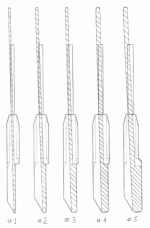Sorry I've been so slow following up on Tony's questions on this topic. The delay is largely due to being on the road for a couple of weeks, but also because (in the interest of disclosure) I have a vested interest in the topic. That, because I'm one of the partners in Clark & Williams, and we make and sell hollows and rounds - along with a range of other 18th century style side escapement as well as top escapement planes.
As Tony has observed, the numbering and sizing of hollows and rounds, historically, is one full of variations and exceptions. And any attempt to sort it out can be quite confusing - and, maybe, not terribly helpful to someone interested in making their own hollows and rounds. Unless they are wanting to fill out an existing set.
With that in mind, I thought I'd simply try to explain the convention we've arrived at and which we have found useful. It is largely based on British convention which tended to be followed by their major planemakers - though there were notable exceptions. And, we have departed from that convention in a couple of minor ways.
In any event, this convention is based on the width of the sole/cutter being equal to the radius of the arc (resulting in the arc being equal to one-sixth of the circumference of a circle). Also, that the number of each pair is equal to the width/radius of that pair in sixteenths of an inch. Thus, the number 2 pair have a radius and sole width of 2/16ths, or 1/8". And a number 10 pair have a radius and width of 10/16ths, or 5/8".
That holds true through the number 12 pairs, after which the increments increase to 1/8". So, a number 13 pair will have a width/radius of 7/8" rather than the expected 13/16". Same for a number 18 pair, which will have a width/radius of 1 1/2 inches rather than the expected 18/16", or 1 1/8 inches. This parallels similar issues with carving gouge sweeps, and is due, we believe, to the fact that the smaller increments don't carry the same visual weight in these slower arcs as they do in the quicker ones.
Also, it is our observation that at least some British planemakers didn't stay with the one-sixth circumference approach (radius equals width of arc) in their larger sizes. We believe this may have been to better control the mouth opening, as well as a couple of other secondary considerations. We've decided not to follow this "exception" in the interest of keeping this aspect consistent throughout our sets.
In any event, this approach results in the following numbers and sizes
Sixteenth inch increments:
# 1 H&R, 1/16" sole width and radius
#2 H&R, 1/8" sole width and radius
#3 H&R, 3/16" sole width and radius
#4 H&R, 1/4" sole width and radius
#5 H&R, 5/16" sole width and radius
#6 H&R, 3/8" sole width and radius
#7 H&R, 7/16" sole width and radius
#8 H&R, 1/2" sole width and radius
#9 H&R, 9/16" sole width and radius
#10 H&R, 5/8" sole width and radius
#11 H&R, 11/16" sole width and radius
#12 H&R, 3/4" sole width and radius
Eighth-inch increments:
#13 H&R, 7/8" sole width and radius
#14 H&R, 1" sole width and radius
#15 H&R, 1 1/8" sole width and radius
#16 H&R, 1 1/4" sole width and radius
#17 H&R, 1 3/8" sole width and radius
#18 H&R, 1 1/2" sole width and radius
As you'll note, I've offset the odd and even sizes in the above table. All 18 pairs would constitue a full set of hollows and rounds, while 9 pairs constitue a half-set, and these half-sets can be either even or odd sizes.
As to what sizes will be most useful, that largely depends on the scale of work you anticipate doing. However, as a general rule, I think it would seldom be the case that one would really benefit all that much by having a full set. In doing furniture work, the larger sizes of a half-set will probably handle most of the occasions when one is making a large cornice moulding and/or ogee bracket feet, while it might be useful to have odd and even sizes of some of the smaller planes. So, for example, an even half-set filled in with the #3, #5 and #7 sizes could prove quite useful.
Since you are interested in making your own hollows and rounds, I thought I'd also mention that the reason we were recently on the road was to tape for a DVD on this topic at Lie-Nielsen Tool Works. While the taping is over, I have no idea how long the rest of the process will take. But, they intend to move fairly quickly on this and I decided to mention it because I believe it will have a great deal of useful and interesting information for someone such as yourself. Again, of course, I must disclose that I have a small commercial interest in this upcoming product.
Hope this has been helpful.
Don McConnell
Eureka Springs, AR

